Interview with Nuka, the Furry Social Psychologist
(This is the original interview conducted in English with Nuka, by Golden Mickey. If you wish to read the Spanish translation, you can do so here.)
Nuka (full name Dr. Courtney Plante) is a 29-year-old furry born in Canada who lives part-time in Iowa (Midwest USA), where he works as a post-doctoral researcher. Besides previous studies, he holds a Ph.D. in Social Psychology. He’s co-founder and member of the International Anthropomorphic Research Project (IARP), through which, with a team of highly qualified colleagues, has researched & published over 15 peer-reviewed papers about the furry fandom and related fandoms. Through this project he’s kept making, for years, scientifically sound psychological survey-studies, aiming to understand the demographic landscape, social connections, and behaviour, of individual furries and the fandom as a whole.
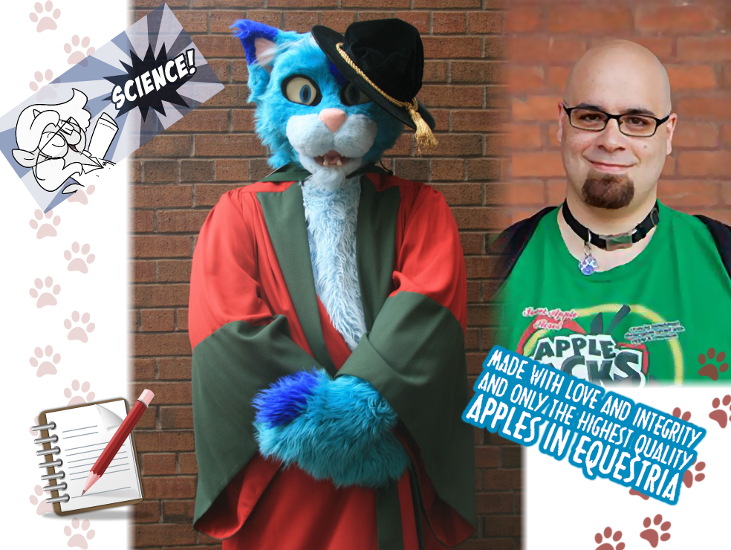
GM: First of all Nuka, you look really cute in your fursuit with the doctoral garb! What was the reaction amongst university colleagues?
Nu: Aww, thank you! Well, it didn’t really surprise any of my grad school colleagues – they’d all known me for a number of years, and I imagine they were pretty sure I’d throw on the suit for convocation. The much more interesting part was walking around campus with the suit and graduation garb on – I think I wound up on about 1,000 people’s Facebook pages the next day, because all the other graduating students wanted pictures with the Doctor Cat – I think a bunch of them figured I was a mascot or something.
GM:  You should have been! Nuka for mascot!
You should have been! Nuka for mascot!
GM: I’ve seen some evolving in your FA gallery, do you now identify yourself more with a pony rather than a cat?
Nu:  Nope, Nuka’s always been, and will always be, a cat. About the only evolving he’s done over the years has been to go from his original puke-green to Kool-aid blue (since I’m color-blind, I decided to make him blue, since I can actually see it!) The pony artwork on my FA gallery has more to do with my learning to doodle in recent years. I enjoy My Little Pony, and the style is relatively simple to pick up, so I figured it would be as good a place as any for me to learn to draw!
Nope, Nuka’s always been, and will always be, a cat. About the only evolving he’s done over the years has been to go from his original puke-green to Kool-aid blue (since I’m color-blind, I decided to make him blue, since I can actually see it!) The pony artwork on my FA gallery has more to do with my learning to doodle in recent years. I enjoy My Little Pony, and the style is relatively simple to pick up, so I figured it would be as good a place as any for me to learn to draw!
GM: Oooohh! Well yes, the artwork of MLP is simple. Just out of curiosity, do you know what kind of color blindness do you have? Protanopia / Deuteranopia? [the most common]
Nu: As a matter of fact, I do! Deuteranopia – it’s when the “red” and “green” cones in your eye are a bit warped, and have overlapping ranges of light wavelengths that they respond to.  Sorry – I’ve taught courses in perceptual psychology, so I’m used to teaching / explaining color-blindness like this!
Sorry – I’ve taught courses in perceptual psychology, so I’m used to teaching / explaining color-blindness like this!
GM: Foremost, I want to begin by talking about your current research, so furries get to know what it is and how they can contribute. It’s a longitudinal study. What does this mean? How is it different from previous surveys?
Nu: Well, at any given time, we’ve got several different studies in preparation or on the go. But yes, our longest and still-ongoing study is the longitudinal study, and you can compare it to some of our previous studies, which are called cross-sectional studies. In a cross-sectional study, you take a “snapshot” of the fandom, so to speak. Basically, give a survey to a bunch of furries to get an idea what the fandom is like right now. The problem with cross-sectional studies, however, is that they can’t answer questions that have a “time” element to them. So, if we ask furries “how do you feel about animal rights?” and “do you identify with your fursona species?”, we may find that those two variables are correlated. However, we can’t say, in a cross-sectional study, which one came first: does the person’s caring about animal rights cause them to identify more with their fursona, or the other way around? A longitudinal study lets us do that: we survey the same people over and over again, once a year, giving them the same questions (and some different ones), to see how their answers change over time. This lets us figure out “oh, variable X changed and then, a year later, variable Y changed, so X must have caused Y!”
As for how to contribute – any furry over the age of 18 is welcome to participate! [Please, underage furries, don’t falsify scientific studies.] The easiest way is to send me an e-mail ( cplante (at) iastate.edu ) and let me know that you’re interested in participating. All we need is an e-mail address where you can be reached, and then, once a year, for the foreseeable future, we will send you a link to that year’s survey.
GM: One of the things you want to research further through the longitudinal study is, from a general perspective, why do people leave the fandom. You’ve stated that furries, for the most part, don’t leave the fandom because of some sudden event, but they lose interest gradually. Also, we are bad at predicting when this might happen. What do you know so far?
Nu: Funny enough, we still know very little about folks leaving the fandom as of yet! It may take another few years of the longitudinal study before we have enough people who leave to be able to provide some illuminating responses. At this point, all we’ve really got are theories. That said, they’re not theories we pulled out of nothing – many of them are based on well-established psychological principles. I, personally, believe that the biggest source of furries leaving the fandom is a combination of “the fandom isn’t what it used to be” (changing norms, shows, artists, etc… over time make it less familiar) and the fact that most furries end up developing a group of friends through the community and, over time, they can hang out with those friends without “needing” the furry side of things. They can just hang out outside of a convention or meet-up. But yes, that last point is true – people are notoriously bad at predicting their future feelings – there have been a number of psychological studies about that very thing, showing that we’re supremely confident that we know how we’ll feel about something… until it happens. And the evidence is there – the vast majority of furries believe that they’ll still be in the fandom 10 years from now [see graph]. But the data suggests otherwise!
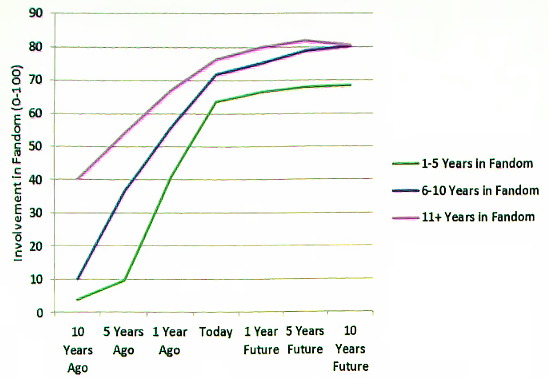
GM: You have, what I believe is, one of the coolest jobs on the planet. In your daily workplace & research, you get to do science, mixed with furry. You sometimes lecture students on what the furry fandom is, and they have to endure it. How has this made you who you are, or changed your life?
Nu: Oooh, great question! I would definitely agree that I’m lucky enough to have one of the coolest jobs on the planet. I get to study furries, and video games – two of my favorite hobbies. And I get to do science, on top of it all, which is always mind-blowing to me. I can sit down, analyze some data, and say, at the end of the day, “I learned something today that, in all of the history of mankind, no one has ever known.” That’s really humbling, and it definitely beats the day-to-day grind of an office or routine job. And actually, I wouldn’t say that my students “endure” my lectures on furries at all – it’s almost always the lecture everyone talks about and looks forward to – so much so that the attendance in those classes shoots up dramatically, and other professors ask me to give the “furry lecture” to their classes!
As for how it’s affected or changed me, well, I would say that it’s helped me to feel like I fit in someplace, both academically and in the fandom. When I first joined the fandom, I was nervous and overwhelmed – there were so many amazing artists, writers, performers, musicians, organizers, and very social people, and all I could think about was how I wanted to contribute to it somehow – I wanted to give something to the community! But I’m not much of an artist, or a musician, and I’m pretty shy! But I like science, and I’m pretty good with stats, so I found my own way to give something to the community that’s given me so much! And it’s helped me find my way in academia – I no longer feel that sense of floundering, of wondering “what can I study that’s new, that hasn’t been done before?”
GM: It’s a very unique, useful and notable way to contribute!
GM: In 2012 you were featured on a National Geographic episode of the series “Taboo”, Season 8, Episode 2: “Secret Lives” (link 01 ⇒) (link 02 ⇒). The furry section of the documentary was concise, not really very informative [they confuse furry fandom with therianthropy e.g.], but actually not unpleasant to watch. You appear calm, explaining your interest for furry as a means of self-expression. Also, you looked quite more hairy than nowadays. Was the experience of being filmed / interviewed satisfying?
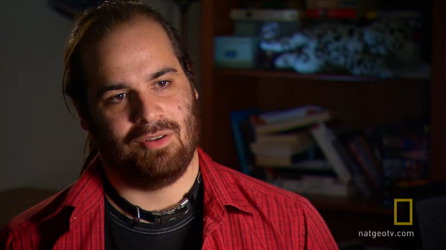
Nu: Ugh… To be honest, I was actually pretty unhappy with the whole thing. The whole experience was incredibly stressful. I’m a pretty shy and private person, so having video cameras around me for 8-10 hours a day for a few days at a time was a bit overwhelming. I don’t think the piece was in any way “bad”, but it was very disappointing, when I consider what it “could” have been. I was really hoping that my role on the show would be as an expert – as a person who could give statistics and numbers and really teach people “hey, here’s what furries are.” And in fact, there was over an hour of footage shot where I was giving all sorts of facts and figures about furries. Of course, none of that got used! Instead, they focused on the fact that I was a furry, which is a bit silly to me. I would consider myself interesting as an expert on furries, but as a furry myself, I’m actually pretty boring! I don’t really have any exciting stories to tell about myself, my fursona is pretty typical as far as furries go… I honestly suggested that they use me for the “boring data stuff”, and go out to find really interesting furries – furries who are amazing fursuit performers or who have really cool stories about things they’ve done or how they got into the fandom. But, instead, they focused on me – arguably one of the most boring furries on the planet! Like I said, it wasn’t bad or insulting or anything like that to the fandom. But it was a missed opportunity, I think.
GM: This is a sentiment many other furries can agree with. No matter how much research and passion and cool stuff they put into giving to the media, ultimately they cut off anything that might be culturally significant, profound or interesting. In the best case scenario, it becomes watered down to the point of boring.
Nu: And it goes beyond that too… You could tell that they had misconceptions about furries from the get-go. When they arrived, it was clear that we were not what they were expecting. They showed up, and a bunch of us were at my house, playing cards. They were like “okay… so when do you put on the suits and run around?” We were like “we don’t really do that outside of conventions or furry gatherings.” They honestly thought that I spent the day lying around the house in my fursuit or walking around everywhere in the suit. And, when they realized that wasn’t the case, it became clear to them that, as a group, furries don’t live up to all the hype we get from the media. We’re not really as “out there”, “wild”, and “freaky” when you get to know us. Of course, you can’t do a show about that, so they wheel out a bunch of fursuiters to catch everyone’s eye.
GM: Last year a group of journalists contacted the furries here [Madrid], to record for one of their programmes about stuff that goes on in people’s lives. They had a set number of things they wanted to record with furries, including, in fursuit, going to a bowling alley, and eating at a restaurant. The people here said “We don’t do bowling, that’s something they sometimes do in America but not here. And why would we want to have dinner with the fursuit on, it’s impractical, and you might stain the fur.” “We just hang out & do regular stuff mostly.” So they looked for fursuiters somewhere else in another city. And what do you guess, some months later those show up on TV, bowling, and eating clumsily at a restaurant in their fursuits.
Nu: And they can’t fathom it! They can’t imagine that, yeah, we don’t go out and do crazy stuff in the fursuits everyday (or, even more amazing to them- we don’t all have fursuits!). Eeeyup. All the footage they got of me in the fursuit was literally from my first week of ever wearing my fursuit (I’d happened to get it that week). I was trying to explain to them that I didn’t know what I was doing, that they were really better off finding a person with a professionally-made suit, and with a lot of experience suiting 
GM: Those furry fingers wiggling in the ‘documentary’ were super cute though.
GM: The large majority of furries have a fursona that’s relatively fixed, and also personal. You’ve found that most of our fursonas are animal versions of ourselves, not designed on a whim but carefully chosen by what we feel represents us best: our personality, our passions, or other traits. But also, they reflect “better” versions of ourselves. You say we give our fursonas qualities we’d personally like to have: more friendliness, more optimism, extroversion, attractiveness, confidence… Would you say, therefore, that by acting through our fursonas (be it fursuiting, role-playing, interacting with the community…) we can improve ourselves, therapeutically?
Nu: Hmm, I’d be a bit hesitant to use the word “therapeutically” there, but otherwise, you’ve got it right! There’s a body of research in psychology which suggests that we have multiple “selves” – two of which are our “ideal” selves – who we would be if we had the choice, and our “actual” selves – who we actually are. In general, this research shows that the closer our actual selves are to our ideal selves, the happier we tend to be. And I think, and have been working to try to test the hypothesis that, fursonas represent this “ideal” self for many furries. And, as an added bonus, we not only get to think about these ideal selves, but we get to actually spend time interacting with others as our ideal selves. In other words, if you’re a shy, quiet person, but would, ideally, be more outgoing and confident, spending time as an outgoing, confident version of yourself may actually change how you see yourself. Others will treat you as that outgoing, confident self, and, over time, you may realize that you’ve internalized, or become, that idealized version of you!
GM: In the past you’ve encountered furries who went through psychologically troubling times, and their therapist / counselor advised them to forget the furry fandom. How do you feel about that?
Nu: One of the most troubling things we were hearing from furries when we started doing one-on-one interviews was, as you said, that there were furries who weren’t getting the therapy that they needed because the therapist / counselor had no idea what a furry was. Furries, like anyone else, can suffer from psychological conditions like depression or anxiety disorders. But, where a non-furry would go in and receive help for the condition they’re suffering from, many furries would go into a psychologist’s office only to be told, after the first interview, that being a furry was the problem, not depression or anxiety. This is a real problem, because, for many furries, the fandom is a source of a lot of support – comfort, friendship, and even income in some cases. To be told that the fandom was the problem was not only heartbreaking, but incredibly frustrating for many furries, especially when the fandom was the only thing helping to keep them together. Thankfully, we’ve since published an article on this very subject which will hopefully reduce the problem, and give furries something they can show their therapist / counselor to explain that furry is, in most cases, probably not the problem.
GM: Can you say which article it is, where was it published?
Nu: Sure! The article is entitled “Clinical Interaction with Anthropomorphic Phenomenon: Notes for Health Professionals about Interacting with Clients Who Possess This Unusual Identity”, and it’s published in the journal ‘Health & Social Work’. The article’s abstract can be found here: (link⇒), and if you [the reader] want a full version of it, you can e-mail me ( cplante (at) iastate.edu ) to get a copy for yourself!
GM: The playful way in which we ascribe common traits to certain animal species is one of the appeals of animal-anthropomorphic culture. So, going to some data you’ve collected, for example, we find that fursonas who are a wolf or a dog, are believed to be loyal. Dragons are believed to be strong. Cats, lazy. Foxes, sly, intelligent. Otters, very much fun. And rabbits shy, but also, very much sex-driven! In what ways have you studied how this may relate to actual personal traits?
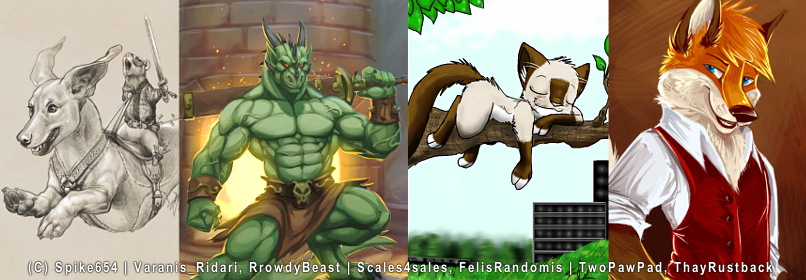
Nu: Aha! You’re thinking exactly like a scientist! Because that’s exactly one of the things we’ll be studying at Anthrocon this year! That’s actually what I wanted to study last year – to test whether certain personalities matched up with certain stereotypical fursona species traits (because we’ve been asked about that in the past – are all people who choose species X like this or that?) I wanted to test it, but the first step was to figure out what the stereotypes were in the first place. Now that we know what the stereotypes are, we can test to see whether people who identify as wolves or cats or foxes would actually use those terms to describe themselves! So, I’ll have an answer to that question in a few months!
GM: However, in the questionnaire, you have to ask in a way that’s not obvious to the reader so they don’t answer what they think they’re expected to answer.
Nu: Oh yeah – we take that into account. We have a lot of practice doing this.
GM: How much work is actually put in validating a questionnaire before printing?
Nu: Well, it typically takes us about two to three months, start to finish, to go from our initial design to printing for a convention. Usually we start off with a big brainstorming session a few months in advance. We talk about past projects and how we’d like to advance them, and we also talk about new projects or collaborators we want to bring on board. Then, we have to go out and see whether anyone’s measured what we’re interested in measuring – it saves us a lot of time to be able to use a previously-validated scale, rather than re-inventing the wheel. If not, we have to invent a new scale. Everyone on the team puts together a big list of questions they want to ask, and they send it to me. It’s my job to take this list of 300-500 questions and chop it down to less than 200 questions. This can take a surprising amount of time to do, and usually involves considering trade-offs – where can we get the most bang for our buck, since we only have so much space on the survey. Once that’s done and gets a final review from our team, it goes off to ethics, who has to review it, recommend changes to it, and finally approve it. It can take a surprising amount of time, and constructing good questions is an art – it’s not as easy as just throwing some words on a page!
GM: But if done right, it remains in the collective pool of useful human knowledge forever!
Nu: That’s the hope!
GM: You’ve delved a bit into therianthropy / otherkins. Furries are often misunderstood for therians; in media, or by people who are unfamiliar with the fandom. Therians are people who identify, intrinsically, as an animal; they believe they have the soul or spirit of a real animal, or identify strongly as one in some other way. The furry fandom isn’t therian, but a sizeable amount of furries are also therians, more so than in the general population. Would you say being therian (having a species identity different from one’s actual species) can be compared to being transgender (having a gender identity different from one’s sex)?

Nu: This is a surprisingly tough question to answer. In a way, my colleague Dr. Kathy Gerbasi made this analogy a few years go, and ruffled a few feathers for it. I would agree that you could use a transgender identity as an analogue for what therians describe their experience as being like, but I would definitely say that the phenomena are not the same thing – they likely have different underlying mechanisms, manifest in different ways, and I certainly don’t want to say that they’re the same thing – I imagine there are plenty of therians and transgender people alike who would take issue with the suggestion that these phenomena are the same. Interestingly, however, we do find that, compared to furries, therians are more likely to identify as transgender.
GM: This is one of the questions you ask in your surveys. Given the opportunity, through some mystical process, to become a real animal, would you choose to stop being human?
Nu: I’m rather fond of being human, to be honest! While I think cats are absolutely adorable, and I definitely admire their ability to be so content with a simple life of eating and napping in a sunbeam, I’m pretty happy as a person, and wouldn’t want to change it!
GM: In regards to sex and gender, why do you think the fandom is, compared to the general population, distinctly non-heterosexual and diverse? There’s more of everything: more homosexuals, more bisexuals, more gender bending, more transgender people, more polyamorous and open relationships, and more asexuals.
Nu: I think the fandom’s more diverse with regard to sexual orientation and gender identity for three reasons.
1) Historically, the fandom has many of its roots in such communities – San Francisco and Toronto are home to some of the first furry groups, both of which have a fairly prominent gay population.
2) The fandom is an open and accepting place, where people are invited to come as they are – something that’s particularly inviting, I would imagine, for people who belong to stigmatized minority groups.
3) The fandom provides a safe and comfortable place for people to explore aspects of themselves. It may be the case, for example, that rates of homosexuality would be much higher if the stigma were removed from it and people were given the opportunity / encouraged to explore their sexuality more openly. In that regard, the furry fandom may help people who are questioning, curious, or who have been thinking about these aspects of themselves to “try it on” and see how it fits.
GM: A graph by [adjective][species] shows furries being increasingly homosexual as they stay in the fandom. Without questioning their methodology, would you be surprised if that was the case?
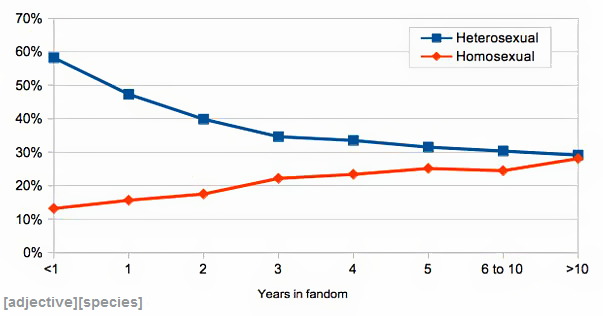
Nu: Actually, I know the folks over at [a][s] quite well, and am well aware of that particular finding (though, I’ve lost track, at this point, of whether the hypothesis was first put forward by them or by myself!) This question is a fantastic example of the type of question that requires a longitudinal study to answer! Because, at the moment, with cross-sectional data, the only way to infer that homosexuality increases with time in the fandom is to ask people how long they’ve been in the fandom and to ask them about their sexual orientation. But there’s no way to know which caused which to happen. However, our longitudinal study will hopefully answer this exact question by looking at the same furries over time and seeing how their sexual orientation may change as they spend time in the fandom! I would certainly not be surprised to see that this is the case, as it’s been my hypothesis for a number of years now!
GM: Well it’s always been a popular thought here… Furry’s a field of turnips. Whoever comes straight turns into ‘fabulous’. (Turnips being a phallic reference.)
Nu:  I’ve never heard that expression before!
I’ve never heard that expression before!
GM: It’s probably a Spanish idiom.
GM: Where would you put yourself in the Kinsey scale? [A scale from 0, meaning exclusively heterosexual, to 6, meaning exclusively homosexual.]
Nu: I’d actually prefer to play that one close to the chest  I’ve found, in the past, that people find it relatively hard to gauge where I stand in that regard, and I suppose I’d prefer to keep it that way
I’ve found, in the past, that people find it relatively hard to gauge where I stand in that regard, and I suppose I’d prefer to keep it that way 
(Though you’re welcome to guess  )
)
GM: I have no clue! I mean, you look in some way effeminate, but that’s not necessarily a homosexual trait. More and more people in the media appear effeminate, but also they’re straight. [“Being campy / mannered is not only an asset for the queer” – Mario Vaquerizo.] In a couple of decades I don’t think behaving effeminately and being actually gay will even be thought of as related.
Nu: It always surprises me to see that I give off mixed signals! 
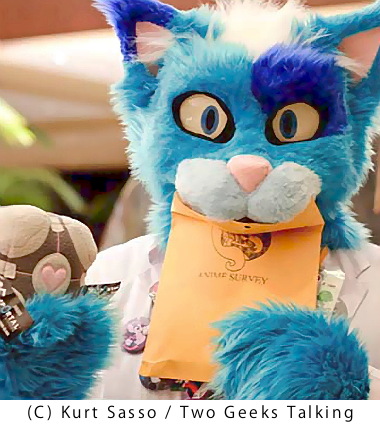
GM: You are also a brony, a fan of My Little Pony (MLP). There is some overlap between furry fandom and brony fandom, but you’ve found there isn’t a consensus on how to approach this. Different people feel differently about MLP fans. What can you say about this?
Nu: When it comes to bronies, the fandom’s pretty mixed in how they feel: about 1/3 of the fandom really hates them, 1/3 of the fandom likes them, and 1/3 of the fandom is ambivalent about them. In general, it’s the furries who are bronies (about 25% of furries self-identify as a brony) who tend to feel positively about bronies. As for the ones who are vehemently opposed to bronies, I suspect it stems, in part, from a belief that bronies are “invading the fandom” – that is, many artists have taken to drawing pony-themed art, and it was a major topic of conversation in the fandom for quite some time (though, it seems that in recent years it’s begun to decline in popularity). I would argue that these feelings are certainly not unique to bronies as a subculture within the furry fandom – similar observations can be found in peoples’ comments about Sonic the Hedgehog, Pokémon, and Disney movies like The Lion King in the past decade or two. And, with the popularity of Zootopia and the influx of furries it may yield, I imagine we’ll be having this same conversation about Zootopia in a year or two!
GM: Except Zootopia is awesome so everyone will love it just as much as I do!
Nu:  It’s always amusing to me, that people who are fans of Pokémon or Sonic can say “ugh, bronies”, without realizing that, a decade earlier, furries were saying “ugh, Pokémon fans”. The times, they are a-changin’!
It’s always amusing to me, that people who are fans of Pokémon or Sonic can say “ugh, bronies”, without realizing that, a decade earlier, furries were saying “ugh, Pokémon fans”. The times, they are a-changin’!
GM: You’ve recently discovered that furries are much more likely to be the older child of the family, and this is also my case. Do you dare speculate why this is so?
Nu: I wish I had a better answer for you – but, to be honest, that’s one of the weird quirks that we have absolutely no answer for! There’s been a little bit of research in psychology looking at birth order and the things that it predicts, but nothing, as far as I’m aware of, would predict the numbers that we found. Of course, it’s entirely possible that it was a statistical fluke, and in a future survey I definitely want to test it again, to see whether that was the case. However, if it’s not, and it really is the case that furries are far more likely to be the older sibling (as it is in my case as well), we’ll be scratching our heads to figure out why, that’s for sure! But that’s what makes science so much fun! Mysteries like this!
GM: May I hypothesize? The older child usually has more responsibility, or has a more rough terrain to go through in life than a younger child. So furry fandom might be a way to channel the desire for a world of fluffy bunnies and cutsie stuff.
Nu: It’s entirely possible! But here’s the problem with what’s called “armchair”, or “speculative” psychology. I could come up with an equally plausible alternative explanation: Research has shown that younger children are more likely to be “the artistic ones”, in rebellion of older children (who, because of stricter parents or more attention given to them when it was just them, may do better in school). So, because of this preference for “artistic” endeavours, they may be more drawn to the furry fandom!
Ultimately, as I always say, “it’s an empirical question” – they’re both plausible explanations, so we’d have to test it with a study to see which of our explanations is wrong, right, better, or worse! Let the data do the talking!
GM: Anyhow, your data shows the number one reason why people become furries is because of the internet. Doesn’t it prove this other hypothesis?
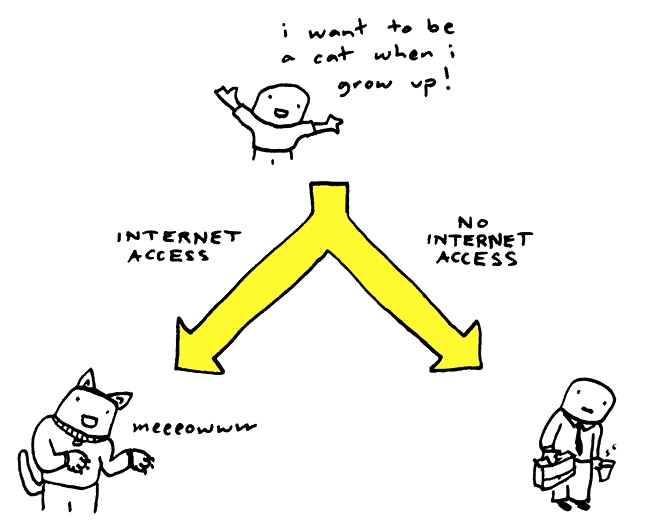
Nu: That picture is absolutely fantastic, and I think I may have to use it in an upcoming presentation. And yes, it would certainly provide evidence in support of that particular model!
GM: Amongst the things furries really like there’s sci-fi, videogames, cartoons, webcomics, and artwork. Amongst the things they’re more or less into there’s anime, MUCKs / role-playing, and tabletop gaming. A thing furries hate is sports. Why do you think furries don’t like local teams moving a ball to some place in a field, in order to score more points against rival teams?

Nu: I don’t think furries have an intrinsic hate of the idea of spherical projectiles on athletic fields, in and of itself! I think many furries are averse to sports for two reasons.
1) Sports represent an accepted, mainstream fandom. It’s socially acceptable for a person to be a sport fan, and there are many sport fans. In contrast, many furries are forced, because of stigma and other factors, to keep their interests relatively secret or, at very least, to not be as brazen and outgoing about them. It could certainly create some animosity toward sport fans, especially if you consider that many furries also identify as geeks, which are a relatively well-known counter-culture.
2) Many furries also report a history of having been bullied in their childhood / formative years. As such, they may develop a bit of dislike toward those who are more popular (e.g., preps, jocks), who may well have been the ones doing the bullying.
These explanations, as well as others, make more sense, especially when you consider how many furries have fursona species that like to chase balls (dogs, cats, etc…)!
GM: I recall a recording of a group of greymuzzles [including Fred Patten] discussing the furry fandom in a convention in the 90s. One of the things they talked about, was “Do you think furry fandom will keep its appeal if it becomes popular?” And they answered, no. They thought many people would leave the fandom if it becomes mainstream one day. We aren’t mainstream yet, but the fandom has grown a lot since then.
Nu: True! But we’re still a long way from “mainstream!” Although, it raises another interesting possibility: Groups don’t really “disintegrate”, especially not groups as cohesive as the furry fandom is. Instead, as they grow, they tend to “fragment”, so to speak. In fact, in a way, that’s how the furry fandom came into existence! As a group grows larger and more unwieldy, people begin to split off and specialize. As the science fiction fandom grew and grew, it allowed for more people interested in stories about “funny animals”, about planets of walking, talking cat-people together. Eventually, a critical mass of them grew and decided that there were enough of them to split off and have their own con. I suspect, if the fandom continues to grow, that sort of fragmentation and splitting off will happen.
It may well be the case that, as furry conventions and furry art websites continue to grow, more meaningful subgroups will form and split off from the group. Perhaps, in ten years, fursuiters will form their own community. Or perhaps there will be enough furry writers to form their own fandom specific to writing stories about furries, without any interest in fursuiting, music, or graphical arts. Or it may split based on content – perhaps furries interested in more feral style content will split off from furries who prefer more anthro content!
But it wouldn’t have to be a bad thing, of course! Not like a furry civil war or anything like that. More of a “specialization”. You can see something similar happen in regional furry groups. If there’s only, say, 10 furries in an area, they’ll all hang out together, despite likely having very different interests. Two of them may be artists, three of them may be gamers, one may be a writer, and so on. But, in a large regional group of, say, 300 furries, the furry writers will tend to congregate together, because they have more in common, and the furry gamers will do the same thing. They become their own subgroup within the larger, broader group.
GM: Another aspect you’ve studied within the fandom is the relationship between artists and commissioners. Artists believe commissioners are very demanding and self-entitled, meanwhile commissioners believe they’re patient and flexible. What would you say to each group?
Nu: I’ve been interested in this topic for a few years now, with the hope of being able to do exactly as you’re suggesting: to be able to give advice to both artists and commissioners.
To artists, I would recommend gently reminding them that for every bad customer or horrible review they get, there are dozens of people out there who love their work and will happily commission them. To recognize that they are biased to remember the bad ones, and to practice letting go of those bad commissioners. I’d also recommend to artists that they take time to work on pieces that they want to work on every so often, to make sure that they rejuvenate their passion for their craft, so it doesn’t become “just a job” for them.
As for commissioners, I’d recommend that they keep in mind that artists are people. They often have school or work outside of the commission work that they do, and they’re also people, just like anyone else, who get tired, need a break, stress out, and have personal problems that can interfere with their work.
I think both sides would also benefit from clear expectations that are agreed upon from the get-go, and from clear lines of communication – letting artists know what’s expected and that you’re able to pay on-time, and letting commissioners have an honest estimate regarding timelines and progress, and being honest about the ability to deliver on expectations. That would get rid of 80% of the problems that artists and commissioners frequently encounter.
GM: Are you aware of monetary issues that come up now and then? Like artists wanting the money upfront but then not delivering. Or someone wanting a refund when the money has been spent already. Or having a commission drawn but the artist not actually getting paid. I don’t think it happens very often but sometimes it does. Do you know anything about this?
Nu: Hmm, we’re only just getting started in our research on artists / commissioners, so, at the moment, no, I can’t say we have any data specifically about these sorts of issues. I am planning, sometime in the next year, to do an artists / commissioner specific survey though, which will hopefully address these very issues!
GM: You’ve found that, in comparison to other fandoms, furries are the least likely to tell others about their interest for animal-anthropomorphic culture, not unlike homosexuals “staying in the closet”. People are generally multifaceted, have different interests. While I may have an interest in bioethics, it’s not something I would talk about generally with furries, nor would I talk about furry with co-workers unless prompted. Though, in an ideal world, we’d like to talk to anyone about our passions in life. How important for our well-being is it to be open about furry?
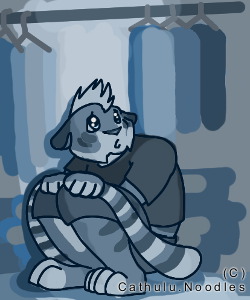
Nu: We’ve actually published an article in the journal Leisure/Loisir a few years ago on this very topic, entitled “Deeper leisure involvement as a coping resource in a stigmatized leisure context”. The gist of the paper is that it’s not so important that furries be able to be outgoing about being furry so much as it’s important that furries not have to “keep it to themselves” or “hide it”. In other words, parading the fact that you’re a furry doesn’t really do much for your well-being one way or another. But being forced to conceal or hide the fact that you’re furry is actually really bad for you – because a similar thing has been found in gay people. When people have to hide their identity, it’s stressful – you have to be constantly vigilant about what you say to other people, and self-monitor to make sure you don’t accidentally “give it way” or “out yourself”. It also causes constant anxiety – what if your parents found out? Your partner? Your boss? That sort of stress is really bad for a person, especially when it’s chronic. Humans aren’t designed to be constantly under stress, and it takes a toll on your immune system and your physical health, in addition to your psychological well-being.
So, I wouldn’t say that furries should go to the rooftops and yell out that they’re a furry for all to hear. But yes, in general, it’s better for furries if they’re in a situation where they have people they can confide in and where they don’t have to constantly stress about what would happen if people found out they were a furry.
GM: There are many variables that can predict the level of well-being of a person: physical activity, sleep quality, healthy / non-healthy diet, smoking / non-smoking, employment, education… One of the best predictors of well-being you describe is having a social support network, friends, relationships. “Having people who are there for you when life gets hard, is one of the best predictors of well-being, and the fandom provides that for people.” How can the furry fandom make someone’s life more fulfilling?
Nu: Well, the furry fandom does provide a lot of people with a sense of identity and a sense of purpose – both things that can help make people’s lives more meaningful and fulfilling. When you feel like you’re part of something bigger than you, and when you feel like you’ve got a distinct identity, it’s good for self-esteem and overall life satisfaction. And, perhaps most important, the fandom provides people with that social support you mentioned. Social support is resilience – it’s resources that you can draw upon when life gets hard – whether it’s trying to cope with psychological trauma or loss, or simply with practical issues, like being short on rent or needing a place to sleep for a few days. The fandom provides people with that social support, which can, in some cases, even be life-saving. So, insofar as the fandom provides people with an identity, with a group to belong to, with a sense of meaning, and helps bolster their resilience against the struggles and hardships in life, it can absolutely improve the quality of life for furries.
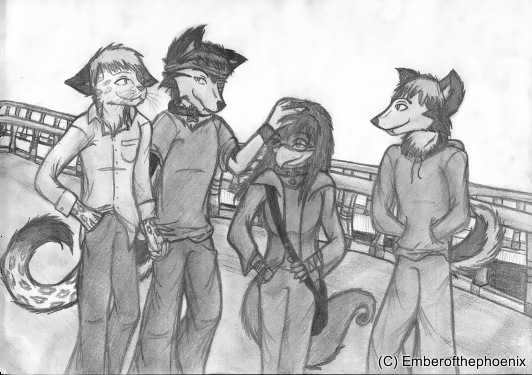
GM: Taking into account everything you’ve learned from the furry fandom through the years, how would you describe it? How would you describe the furry community?
Nu: The fandom is a community, first and foremost. It’s more than just people sharing a common interest occupying the same spaces online or in-person. It’s people with a passion, with creativity and openness to new ideas sharing those ideas and openly seeking out new experiences and new friendships with others. And it’s genuine friendships and relationships that are formed through the fandom – people who may start to interact with one another because of a shared interest, but who form deep and meaningful bonds with one another over time. I think that’s the structure that underlies the fandom, when you strip away all the furry content. It’s relationships and community.
an interest that’s central to who they are and the group that they belong to.”
“This is what the media gets wrong about the furry fandom.
They show pictures like this, hundreds of fursuits.”
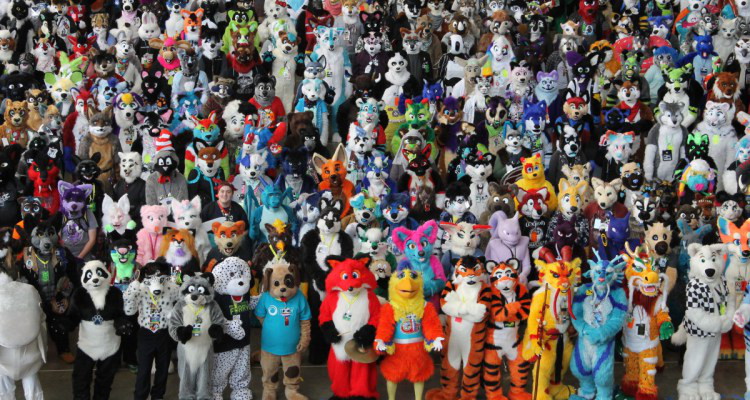
“That’s wrong, that’s not how furries look like. This is what furries look like.”
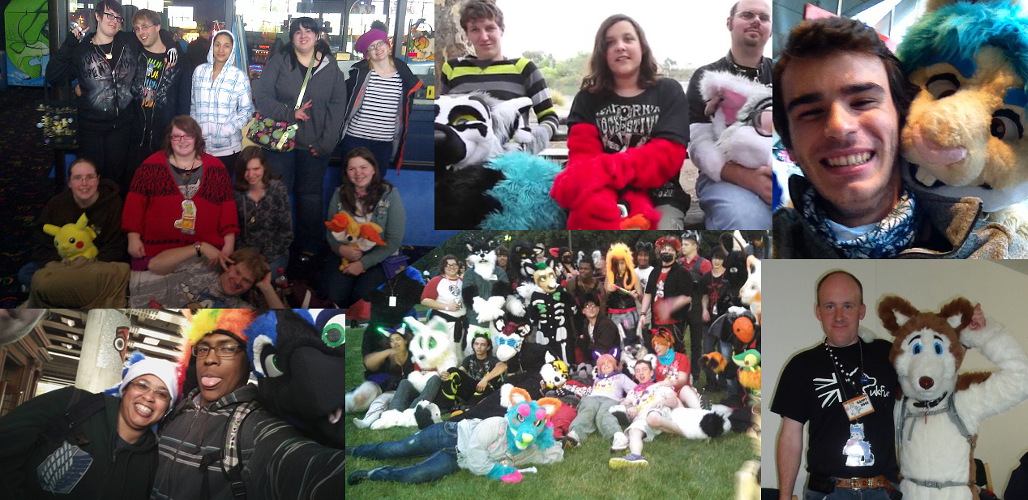
“Furries are people, hanging out with other furries.
And that’s what makes this fandom so special.
That’s why we love to study this fandom. Because of these relationships.”
– Nuka
GM: Picking up and finishing the interview, I only have two small questions. First, have you finally seen Zootopia? Or do I have to call the furry police?
Nu:  I have seen Zootopia, and I absolutely adored it! Funny enough, my favorite scene, the scene I could watch over and over again, is when Judy is on the train, arriving in Zootopia for the very first time. The animation, the music, the sense of wonder it created. If the film doesn’t receive a ton of Academy Awards next year for that scene alone, it will be a travesty!
I have seen Zootopia, and I absolutely adored it! Funny enough, my favorite scene, the scene I could watch over and over again, is when Judy is on the train, arriving in Zootopia for the very first time. The animation, the music, the sense of wonder it created. If the film doesn’t receive a ton of Academy Awards next year for that scene alone, it will be a travesty!
GM: Yeeeeeeey! Another convinced Zootopian!! 
GM: And, can we expect to see you in this year’s Eurofurence (August 2016)?
Nu: As much as I would absolutely love the chance to, I don’t think it’s in the cards this year – I’ve already added two new cons to my regular circulation – Further Confusion and Midwest Furfest. However… I’ve not ruled out the possibility of Eurofurence next year 
GM: Yeeey!  Funded by the Government of Canada? For science?!
Funded by the Government of Canada? For science?!
Nu:  We’re currently not funded right now (we ran out); so we’re applying for more, at the moment. So, at the moment, I have to make it out to cons out of my own pocket! But I love what I do, and I don’t mind paying for my own science.
We’re currently not funded right now (we ran out); so we’re applying for more, at the moment. So, at the moment, I have to make it out to cons out of my own pocket! But I love what I do, and I don’t mind paying for my own science.
GM: It’s been a real pleasure talking to you Nuka. And it’s been a long interview. Thanks for bearing with me!
Nu: Oh, not a problem! Thank you for taking the time to be well-informed beforehand 
GM: You can find Nuka at FurAffinity (Nuka-Kitty), and at the IARP website (link⇒). He remains approachable and is happy to assist in anything regarding his studies. Please consider taking part in his online surveys, or filling his questionnaires whenever you get the chance to see him at a convention.


